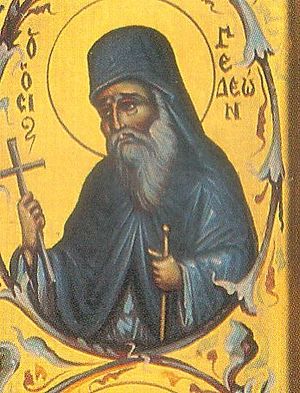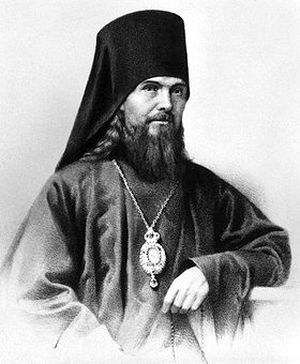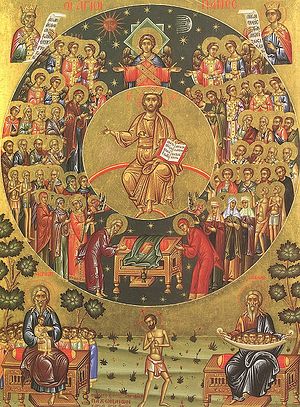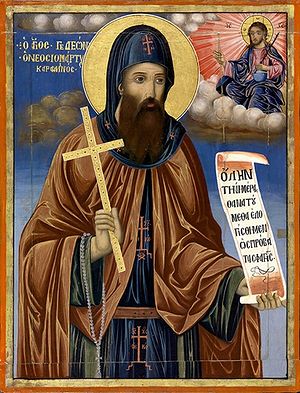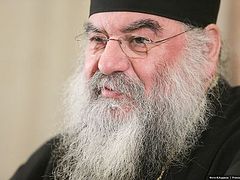My first “encounter” with St. Gideon happened through reading about a different example of holiness; he was mentioned in the “Life” of the righteous Abbot Codratus of Karakallou (†1940) in the Second Volume of Archimandrite Cherubim’s work Contemporary Ascetics of Mt. Athos. Elder Codratus had a great love both for St. Gideon and the small chapel built in his honor. The Abbot would often hear the confessions of the brethren in or just outside the chapel, loved to pray to him and delighted in telling others of the saint’s life and struggles.
There have been other saints both ancient and recent who had a special connection with another saint throughout the history of the Church. St. Gregory of Tours (†594) had a deep veneration for St. Martin of Tours (†397), for example. The recently glorified St. Iakovos of Evia (†1991) loved St. David of Evia (†1601), and St. Paisios of Mt. Athos (†1994) was very close to the Great Martyr Euphemia (†304). But there was something about the account of Abbot Codratus’ love for the New Martyr Gideon that spoke to me and left an impression that has lasted up to this day.
These “heavenly connections” with those saints were undoubtedly one of many gifts that God, the Father of lights (James: 1:17), sent to His servants and that have the ability to touch and inspire other souls. His saints and the other world are closer than we realize, and His direct and personal action towards us is both continual and filled with His loving care. One of the characteristics of the saints was that they had striven to become aware of this fact in their own lives; the Remembrance of God for them became the compass from which they lived and navigated their path to the Kingdom of Heaven. As we strive to become closer to the other world, the saints, the angels and God all become closer to us.
In fact, if we look at the Lives of many of the holy and righteous men and women who lived throughout the centuries we are sometimes struck with just how close the other world was to them—in some cases it seemed as if the invisible world were just as real (or even much more real) to the saints as the visible one, and this was especially true regarding the Creator of both worlds: for many of the saints God was the “most real” of all realities, not as an idea or theory, but as reality Himself.
However, most of the saints and the righteous did not develop such an awareness and/or grow into saints in a split-second; many of their lives testify to the lengthy and drawn-out struggles and difficulties they had to face particularly from their own fallen nature and bad habits, and sometimes from people around them or directly from fallen spirits. The lives, writings and teachings that have come down to us speak of many things, but one of the things they also address is how they began to multiply the talents given to them by God in this life (cf. Mt. 25:14-29) and bore such beautiful spiritual fruits.
St. Theophan the Recluse (†1894) titled one of his books The Spiritual Life and How to be Attuned to It, and that indeed is what living our lives as Orthodox Christians involves—attuning ourselves to “seeing”, hearing, understanding, fulfilling and “making our own” the Law of Christ and His Grace; literally becoming “Christ-bearers”. God Himself, specifically the Second Person of the Holy Trinity, came down to earth and clothed Himself in flesh taken from the Holy Theotokos so that He would be immediately and even extremely accessible to where mankind had found itself after the Fall. Of course this is what the present Nativity feast is about: God revealing Himself to us, speaking directly to us and “re-fashioning mankind anew” through His life, death and resurrection in a particular yet necessary way before His ascension back into Heaven.
However, God has not stopped speaking to us since then. He continued and continues to be simultaneously active in the life of each and every person throughout history down to this day. He has never abandoned us and is always calling to us, protecting us, supporting us. However mankind as a rule, even those who have been raised Orthodox Christian in ideal possible circumstances (a rare thing these days) is not really “used” to “hearing” how He speaks to us, and is largely unfamiliar with “how He operates”. We are unfamiliar with the “taste of the heavenly.” This should be no surprise—to varying degrees this has always been so, but it could be argued that it is especially the case in the past century or so. Even so God has guided the recent saints, righteous men and women, to show us how to begin to re-cultivate the “inner taste” for what is holy.
Before all else we must begin to become aware of these Grace-filled movements or communications on the one hand, and especially being able to process them both in a way that is spiritually profitable and reflective of how we ought on the other—both are well summarized in the teachings of St. Paisios of Mt. Athos and Elder Thaddeus of Vitovnica (†2003) on “positive thoughts” and the salvific humility and love they birth. St. Paisios in one place even goes so far as to say that God “cannot” help us, even if He really wants to, unless we acquire a positive way of thinking!
Back on topic, though … God continues to care for us and reveal Himself to us, yes, and does so both in the past as well as in the present. Some examples of the past are found in the Holy Scriptures, the Lives and Writings of the saints of His Church, and other artistic expressions of the Faith that have come down to our time through the ages: architecture, iconography, chant, etc. These are sources of a reservoir of potential Grace that we should consistently expose ourselves to and strive to “tap”, enter into and make our own as best we can.
However God is also caring for us and speaking to us on a day-by-day level as well in the “present”. Some examples of this come through other Christians or people we meet on an everyday basis (and especially if we are fortunate to encounter living holy men and women of God). But there are two other sources of God’s direct transmission to us that we can avail ourselves of: first, what St. Nektary of Optina (†1928) calls “the grace of the day,” and secondly what the righteous Archimandrite John Krestiankin (†2006) termed “the stream of God’s Providence.”
One aspect of “the stream of God’s Providence” mentioned above relates to how God directs our individual lives, arranging and permitting things to come across our path or befall us always with our spiritual growth and especially moral betterment in mind. People we meet, experiences we come across and the rest are all potential “raw material” that can be used to draw us nearer to God, to become more Christ-like by responding in accordance with God’s moral law, whether in our deeds, words, feelings or thoughts, and both through our actions and reactions. Archimandrite John elsewhere speaks more about this, teaching that, “Life itself teaches life.” In other words, God, the Lord, the Giver of Life Himself guides each one of us through His Providence and care to teach us how to live in accordance with the Gospel that we might truly live.
Elsewhere in the collection of his letters titled May God Give you Wisdom! Archimandrite John enlarges upon how all is upheld by God’s Providence, saying that “Our life is endless—a ring or circle in God and with God.” The Church Fathers often speak of how seeing God’s hand in all things (as it truly is!) is a practical manifestation of faith, and faith on many levels, especially including St. Paul’s definition where ...faith is the substance of things hoped for, the evidence of things not seen (Heb. 11:1). In other words, faith is the beginning (and ideally the continued development) of seeing reality as it truly is. As Fr. John teaches above the way we begin to see reality now will continue and deepen continually in eternity after we pass from this life.
So God “speaks to us,” conveys His will to us, gives us occasion for instruction every day, every moment through His Providence. But He also speaks to us in the present through “the grace of the day.” “The grace of the day” as mentioned by St. Nektary of Optina refers especially to God’s teaching, instruction and will for us as manifest through the Church’s prayers and sacraments, and especially through the Cycle of Services offered to Her children throughout the course of the year.
Each day of the year is filled with saints and events commemorating things happening during the lives of our Lord or His Mother, celebrations of miracle working icons, and so on, and each saint or commemoration is it’s own “pulse” or heartbeat in the organism of the Church’s life as a whole, sending out it’s “grace-filled blood” that is filled with spiritual nutrients and things necessary for our soul to live and grow by. The hymns, the selected scriptural verses, the Old Testament readings chosen in honor of the event, the New Testament readings for the same purpose … all of these things form an organic whole and are presented as a richly laden table for all to come and nourish themselves on.
And Our Lord speaks to us through the living commemorations, prayers (of both repentance and rejoicing) and celebrations throughout the year and her visible and invisible seasons, and He speaks to us directly, both on a general level, a specific level, and also sometimes on a personal level of meetings or encounters. It can be through instruction, touching our heart, surprising us with some gift or inspiration, moving us to repentance, showing us something about ourselves we were previously unaware of, and many other things … but whatever it is that we find coming our way in response to our efforts of attention to what the service is presenting to us, to striving to take the words of the prayers and hymns and making them our own, the response we give must be one and the same: it must be a response of a certain type of gratitude, a thankfulness that simultaneously fills us with a quiet inner happiness and a contrition and sadness when we see how we have been given good things and are loved, and yet fall short of the many gifts we have been given, are being given and will be given.
Because the Church services and sacraments are so overflowing with God’s grace and so packed with the potential for speaking to each one of us in our own circumstances or difficulties, the saints of the Church (such as Sts. John Climacus and Dorotheus of Gaza) valued them very highly, and would even speak of how one of the telltale signs of one’s love for God beginning to wane is avoiding that very “stream” in which our soul was made to live and breathe and not attending the communal prayers of the Church. Removing oneself from this source of grace only further leads to the slow death and pain and loneliness of our soul as it asphyxiates like a fish out of water. Such a soul deprives itself of the spiritual unity and oneness that comes from being engaged in reaching out towards the same goal and purpose with both one’s neighbor and the denizens of the Church triumphant. Praying together with others leads to one’s soul being fed by His grace drop by drop, and slowly being filled with meaning, purpose, peace and that characteristic grateful inner joy as it grows in the life of His grace.
Many saints speak of this gratitude, this “responsive gratefulness” (St. Paisios of Mt. Athos used the word “philotimo” for this) that touches and humbles the heart while moving it to love its Creator. One of the main characteristics of it is the desire to “give back”, to pray to God with gratitude first and foremost, yes, but also to treasure and begin the process of cultivating the talents we have been given (cf. Mt. 25:15). This treasuring and cultivation of His gifts is an art unto itself, but an art, the pursuit of which is the most meaningful activity one can live by. We must cultivate it on all levels of our being—in our mind, feelings, actions and especially the deepest core of our being (what the saints would often call “the heart”). Above all, the cultivation should involve developing our relationship with God, His Mother, the angels, His saints, and transforming our interactions with other people: our neighbor.
The many ways one can treasure and cultivate this “grace of the day” is a very large topic unto itself, but one of the most important aspects to this process of growth is cultivate gratitude for His gifts both in the company of others and under the direct guidance and counsel of one who is more experienced. Otherwise, it can be easy to lose one’s way and misunderstand one’s experience. Direct guidance coupled with our interactions with other people we live with on a day-to-day basis both serve as a “sounding board” for our inner and outer activity and is an aid in the cultivation of the virtue of simplicity.
True love, gratitude and humility towards God and one’s neighbor are always interspersed with simplicity and a certain childlikeness. St. Porphyrius of Kapsokalyvia (†1991) spoke about this simplicity, for example, in how we ought to pray, emphasizing that we should love God and pray to Him “without contorting oneself”, we must be forceful in moving ourselves to pray, but not force the prayer itself or even self-manufacture experiences, emotional states, ideas or whatever inside ourselves and not notice that we are doing precisely that (the almost ruthless sobriety and absence of any posing or self-aggrandizement found in the writings of St. Ignatius Brianchaninov (†1865) are especially helpful in identifying these sorts of things). Simplicity and childlikeness that has been both birthed and further refined through the grace-filled cultivation of “positive thoughts” results in seeing things anew.
We begin to see glimpses of the nature of things with the eyes of our soul: neither more than they are nor less. The first thing we begin to see is how our shortcomings, sins, and failings cloud over the Image of God in our soul and interfere with His acting in our lives the way both He and we desire. We begin to truly glimpse our thorough need of God’s continued all-embracing mercy and goodness, and this results in a deeper and more conscientious life of repentance….
We ought especially to strive to be honest with ourselves, and bring ourselves exactly as we are at any moment to Christ, turning to Him however and whenever we can, and wherever and however we are. This honesty, simplicity, lack of guile or lying will help the soil of our soul to be more receptive and fertile to the grace-filled “deposits” God’s love sends our way and will also help us both to see it in the first place and respond with the gratitude we ought.
Sometimes the gifts that God sends will involve an inexplicable feeling of closeness to a particular saint—this can happen as a result of an icon, reading about their Life, hearing the hymns composed in their honor, or any number of means and ways, but if God permits such a thing to occur (and it happens more often than we might expect) the response is the same: simple gratitude and prayer, bringing the experience before one’s spiritual father, measuring one’s reaction against the practical reference point of how one fulfills the Gospel commandments in relation to those closest to one, etc.
Sometimes, though, this relationship can grow into something special, and God “permits” a closeness to grow between the saint and the Christian … and for many reasons. This closeness can even grow to the level of the saints and righteous men and women we mentioned earlier; a closeness that never “replaces” one’s closeness with Christ God Himself, but rather helps to “augment, deepen and enrich” it, and does so for God’s reasons alone—He knows us and knows all, and searches for and utilizes any means or ways He can to bring a single soul just a little closer to Him. And both the heavenly hosts and the saints who have gone on before us are more than willing to help Him in this regard, having become beautiful examples of our Fathers, Mothers, Brothers and Sisters who have gone on before us, finished the race, are themselves every growing more and more perfect in the likeness of the One Who has sent down His gifts on them and on all even now, and who have also come to desire others who are still members of the “Church Militant” to become as they are now in heaven.

